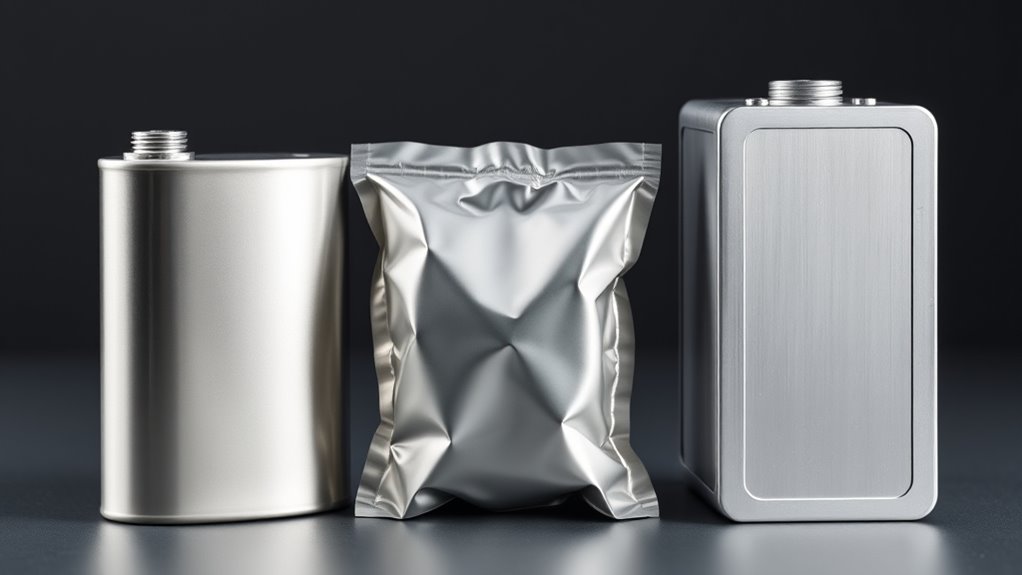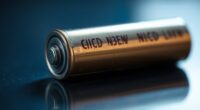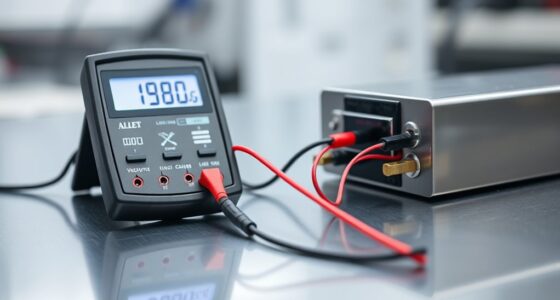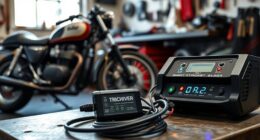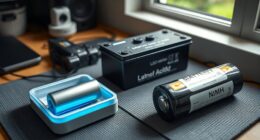Cylindrical, pouch, and prismatic lithium-ion cells each suit different needs. Cylindrical cells are durable, heat-dissipating, but less flexible in shape. Pouch cells offer high energy density and customization, yet require careful safety measures. Prismatic cells provide a sturdy, compact design ideal for space-efficient applications but involve more complex manufacturing. Understanding these form factors helps you choose the right battery type, and exploring their differences reveals how design impacts safety, performance, and integration.
Key Takeaways
- Cylindrical cells are durable, heat-efficient, and easy to manufacture but offer limited shape flexibility.
- Pouch cells provide high energy density and customizable shapes, but require careful sealing and are more vulnerable to swelling.
- Prismatic cells feature rigid casings for safety and space efficiency, suitable for compact, safety-critical applications.
- Manufacturing complexity varies: cylindrical and prismatic cells involve precise assembly, while pouch cells demand advanced sealing techniques.
- Choice of form factor depends on safety, energy needs, device design, and space constraints.

Have you ever wondered why lithium-ion batteries come in so many different shapes and sizes? The variety of cell form factors—cylindrical, pouch, and prismatic—serves specific purposes across devices and industries. Understanding these differences helps you appreciate how battery safety and manufacturing processes influence design choices. Each form factor has unique advantages and challenges that impact performance, safety, and production efficiency.
Cylindrical cells are perhaps the most recognizable, often seen in flashlights or electric vehicles. They are manufactured through well-established processes that emphasize safety and reliability. Their robust metal casing provides structural integrity, which helps contain internal pressure and reduce the risk of leaks or ruptures—crucial for battery safety. The manufacturing process for cylindrical cells is highly refined, allowing consistent quality and efficient mass production. Their standardized shape simplifies assembly, but the rigid design limits flexibility in device integration. Despite these constraints, cylindrical cells are popular because they are durable and have excellent heat dissipation, which helps prevent overheating during operation.
Pouch cells, on the other hand, are distinguished by their flexible, lightweight foil packaging. They offer the advantage of high energy density and customizable sizes, making them ideal for portable electronics and electric vehicles where space optimization is critical. However, their flexible packaging presents unique challenges in manufacturing processes. Since pouch cells lack a rigid casing, they require careful sealing and additional internal safeguards to ensure battery safety. Manufacturing pouch cells involves precise layering and sealing techniques to prevent moisture ingress and mechanical damage. The absence of a metal shell makes them more vulnerable to swelling, which must be managed carefully during design and manufacturing. Their flexibility allows for innovative shapes and integration into complex device geometries, but this also demands rigorous quality control to prevent safety issues, especially during thermal runaway.
Prismatic cells combine aspects of both cylindrical and pouch designs. They feature a solid, rigid casing that provides structural support, making them suitable for applications requiring a compact form factor with high safety standards. Their manufacturing processes involve precise assembly and sealing techniques, ensuring battery safety and durability. The rigid structure allows for better heat management compared to pouch cells, although they are less flexible in shape. Prismatic cells are often used in electric vehicles and aerospace where space and safety are critical. Their design balances manufacturing complexity with performance benefits, but it also requires strict quality control to maintain safety standards throughout production.
Ultimately, the choice among cylindrical, pouch, and prismatic form factors depends on your specific needs—whether it’s safety, energy density, or design flexibility—highlighting how manufacturing processes and safety considerations shape the diversity of lithium-ion batteries you encounter every day.
Frequently Asked Questions
How Do Form Factors Affect Battery Recycling Processes?
Form factors directly impact recycling challenges and material recovery, as different shapes require varied disassembly methods. Cylindrical cells are easier to handle, while pouch and prismatic cells pose more complex disassembly and safety issues. You’ll find that pouch and prismatic designs often contain different materials and layouts, making recycling more difficult and reducing efficiency. Understanding these differences helps you optimize processes for safer, more effective material recovery.
Are There Specific Industries Favoring One Form Factor Over Others?
Like a tailor fitting a suit, industries select specific battery form factors for their needs. For example, the automotive sector favors prismatic cells for space efficiency, while consumer electronics prefer cylindrical cells for durability. Industry-specific applications drive design customization, influencing choices based on energy density, size, and manufacturing ease. Your business benefits by choosing the right form factor, optimizing performance and integration for your specific industry demands.
How Do Form Factors Influence Thermal Management Strategies?
Form factors markedly influence your thermal management strategies by affecting thermal regulation and design integration. Cylindrical cells, with their uniform shape, facilitate efficient heat dissipation, while pouch and prismatic cells require tailored cooling solutions due to their larger surface areas and varied geometries. You must consider these differences to optimize cooling systems, ensuring safety and performance. Properly matching the form factor with your thermal management approach enhances overall battery efficiency and longevity.
What Are the Recent Innovations in Cell Form Factors?
You might think cell form factors haven’t evolved much, but recent innovations like solid-state batteries are changing that. Manufacturers are exploring flexible designs, enabling cells to bend and conform to various shapes, boosting device integration. These advancements improve safety, energy density, and thermal management. As a user, you’ll benefit from more durable, versatile batteries that fit seamlessly into compact or unusual spaces, making your devices lighter, safer, and more efficient.
How Does Form Factor Impact Manufacturing Costs and Scalability?
You find that the cell form factor markedly impacts manufacturing costs and scalability. Cylindrical cells tend to be cost-efficient and easier to produce at scale due to standardized designs. Pouch and prismatic cells, while offering design flexibility, often increase manufacturing complexity and costs because of their custom shapes and handling requirements. Choosing the right form factor balances cost efficiency with production scalability, affecting how quickly and economically you can scale up battery manufacturing.
Conclusion
Think of choosing a lithium-ion cell like picking a vehicle—each form factor has its own terrain. Cylindrical cells are like reliable motorcycles, compact and durable, perfect for rugged rides. Pouch cells are the sleek sports cars, offering flexibility and lightweight performance. Prismatic cells resemble sturdy SUVs, blending size with robustness. Understanding these differences helps you select the right “ride” for your energy needs, ensuring your device runs smoothly, just like a well-tuned engine on a long journey.

